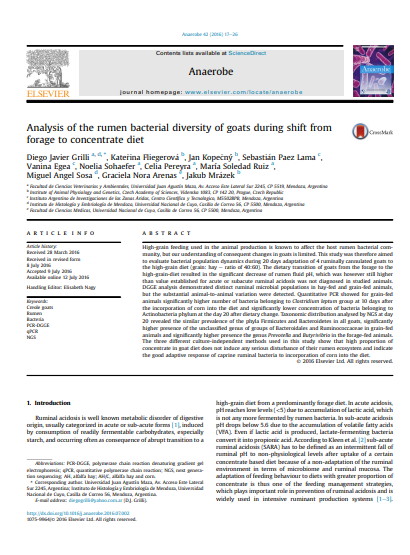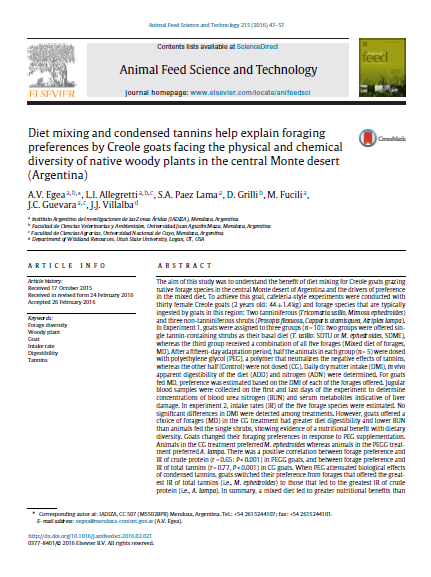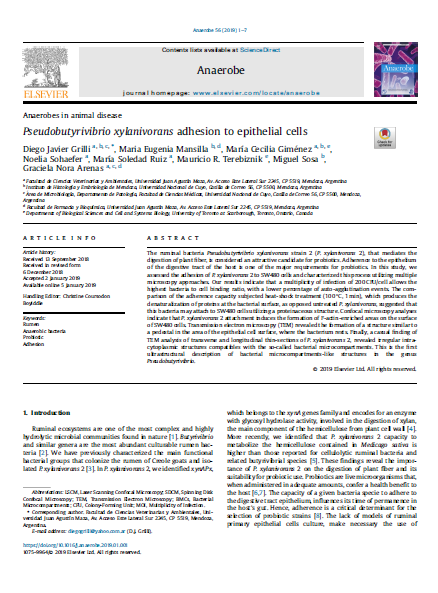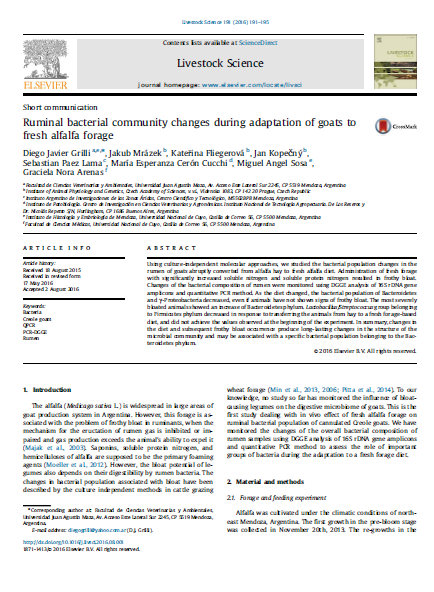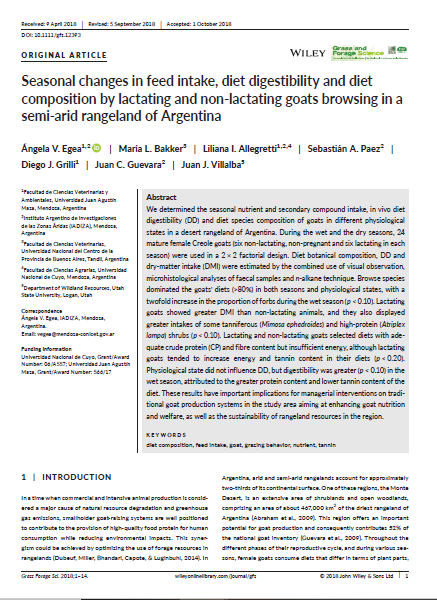Browsing Ciencias veterinarias by Author "Grilli, Diego Javier"
Now showing items 1-5 of 5
-
Analysis of the rumen bacterial diversity of goats during shift from forage to concentrate diet.
Grilli, Diego Javier; Fliegerová, Kateřina; Kopečný, Jan; Paez Lama, Sebastián; Egea, Vanina; Sohaefer, Noelia; Pereyra, Celia; Ruiz, María Soledad; Sosa, Miguel Angel; Arenas, Graciela Nora; Mrázek, Jakub (Comité editor Journal Anaerobe, 2016-07-12)High-grain feeding used in the animal production is known to affect the host rumen bacterial community, but our understanding of consequent changes in goats is limited. This study was therefore aimed to evaluate bacterial population dynamics during 20 days adaptation of 4 ruminally cannulated goats to the high-grain diet (grain: hay e ratio of 40:60). The dietary transition of goats from the forage to the high-grain-diet resulted in the significant decrease of rumen fluid pH, which was however still higher than value established for acute or subacute ruminal acidosis was not diagnosed in studied ... -
Diet mixing and condensed tannins help explain foraging preferences by Creole goats facing the physical and chemical diversity of native woody plants in the central Monte desert (Argentina).
Egea, Angela Vanina; Allegretti, Liliana Inés; Paez Lama, Sebastián Antonio; Grilli, Diego Javier; Fucili, Mercedes; Guevara, Juan Carlos; Villalba, Juan josé (Comité editorial Animal Feed Science and Technology, 2016-02-26)The aim of this study was to understand the benefit of diet mixing for Creole goats grazingnative forage species in the central Monte desert of Argentina and the drivers of preferencein the mixed diet. To achieve this goal, cafeteria-style experiments were conducted withthirty female Creole goats (2 years old; 44 ± 1.4 kg) and forage species that are typicallyingested by goats in this region: Two tanniniferous (Tricomaria usillo, Mimosa ephedroides)and three non-tanniniferous shrubs (Prosopis flexuosa, Capparis atamisquea, Atriplex lampa).In Experiment 1, goats were assigned to three groups (n ... -
Pseudobutyrivibrio xylanivorans adhesion to epithelial cells
Grilli, Diego Javier; Mansilla, María Eugenia; Gimenez, María Cecilia; Sohaefer, Noelia; Ruiz, María Soledad; Terebiznik, Mauricio; Sosa, Miguel; Arenas, Graciela Nora (Comité editorial Anaerobe Journal, 2019-01-05)The ruminal bacteria Pseudobutyrivibrio xylanivorans strain 2 (P. xylanivorans 2), that mediates the digestion of plant fiber, is considered an attractive candidate for probiotics. Adherence to the epithelium of the digestive tract of the host is one of the major requirements for probiotics. In this study, we assessed the adhesion of P. xylanivorans 2 to SW480 cells and characterized this process utilizing multiple microscopy approaches. Our results indicate that a multiplicity of infection of 200 CFU/cell allows the highest bacteria to cell binding ratio, with a lower percentage of ... -
Ruminal bacterial community changes during adaptation of goats to fresh alfalfa forage.
Grilli, Diego Javier; Mrázek, Jakub; Fliegerová, Kateřina; Kopečný, Jan; Paez Lama, Sebastian; Cerón Cucchi, María Esperanza; Sosa, Miguel Angel; Arenas, Graciela Nora (Editorial Livestock Science, 2016-08-02)Using culture-independent molecular approaches, we studied the bacterial population changes in the rumen of goats abruptly converted from alfalfa hay to fresh alfalfa diet. Administration of fresh forage with significantly increased soluble nitrogen and soluble protein nitrogen resulted in frothy bloat. Changes of the bacterial composition of rumen were monitored using DGGE analysis of 16S rDNA gene amplicons and quantitative PCR method. As the diet changed, the bacterial population of Bacteroidetes and γ-Proteobacteria decreased, even if animals have not shown signs of frothy bloat. The most ... -
Seasonal changes in feed intake, diet digestibility and diet composition by lactating and non-lactating goats browsing in a semi-arid rangeland of Argentina
Egea, Angela Vanina; Bakker, María Leontina; Allegretti, Liliana Inés; Paez, Sebastián Antonio; Grilli, Diego Javier; Guevara, Juan Carlos; Viillalba, Juan José (Comité editor Grass and Forage Science, 2018-10-01)We determined the seasonal nutrient and secondary compound intake, in vivo diet digestibility (DD) and diet species composition of goats in different physiological states in a desert rangeland of Argentina. During the wet and the dry seasons, 24 mature female Creole goats (six non-lactating, non-pregnant and six lactating in each season) were used in a 2 × 2 factorial design. Diet botanical composition, DD and dry-matter intake (DMI) were estimated by the combined use of visual observation, microhistological analyses of faecal samples and n-alkane technique. Browse species dominated the goats’ ...







